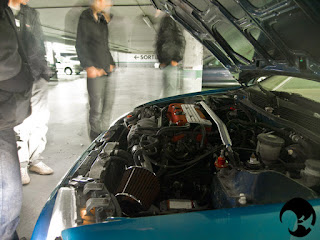Passion is, in my opinion, the strongest drive a human being can have, as it transcends efforts, time, money, well, just about anything that can hinder or motivate people. Some passion are spontaneous and others are induced through other people who we love or admire.
Charles is a mix of both. As spontaneous as his passion for motorbikes and cars is, his love for the Honda CRX was born from his childhood: he lived part of his young days on the backseats of his mom's 1.5L AF53.
Now 26, Charles is driving an 1986 1.6L AS53, powered by the famous 125hp ZC engine.
He bought this CRX about six months ago in a good rolling state. Any ordinary person would have kept the car as-is, but Charles is no ordinary driver, and the grease monkey in him demanded more from the little red Honda.
Thus, the surgery began.
First up was the chassis. The technology behind the chassis being 26 years old, Charles had to face challenges that few of us encounter during this build, and he started by reinforcing the frame with top and lower strut bars at the front and rear.
The question is: where can you find aftermarket support for such an old car?
After searching offline and online, the only solution he found to get these bars was to fabricate them himself. As of today, he just needs to finish the lower suspension arms bar to complete his custom-made, body strengthening set of bars.
The rear axle itself was another challenge since the CRX is equipped with a single rear wheel axle, supported by a Panhard Bar.
A panhard bar is perpendicular to the car and is attached to the rear left undercarriage, and links to the right of the wheel axle. The bar makes the axle move up and down on a circular motion. For example, when driving over a hump, the axle is not moving down and up, but sideways from down to up. To strengthen this bar, Charles had to reinforce the main attach of the panhard bar, under the chassis.
 After the chassis came the suspension system as, stock, the chassis has a clearance of about 70cm, and handles quite awfully.
After the chassis came the suspension system as, stock, the chassis has a clearance of about 70cm, and handles quite awfully.Upgrading the front suspension wasn't a smooth ride as the car sits on very soft torsion bars. The struts are resting on independent mounts, and guide the whole suspension system and the wheel mount. This system was quite often used in the 80's and only a very limited number of brands offer suspension systems for this car. Charles called Upgrade Motoring, in California and upgraded the torsion bars from the OEM 18.5mm thickness to 24mm, which is firm enough for street use.
Upgrading the rear suspension was, once again, not an easy feat as the ancient tech sees the struts and springs resting on separate mounts. This resulted in the inability to use more recent and common suspension systems such as bolt-on coilovers.
 There are currently only few brands that still offer a coilover system that can fit the AS53 and allow lowering of the ride height. Charles contacted Ground Control to get his suspension system, their services giving the opportunity to choose the desired spring rate.
There are currently only few brands that still offer a coilover system that can fit the AS53 and allow lowering of the ride height. Charles contacted Ground Control to get his suspension system, their services giving the opportunity to choose the desired spring rate.A common misconception is that harder is better, and Charles personally experienced that this saying doesn't always apply. Running on a 6.3kg/mm spring rate for a car that weights 350kgs on the rear axle made the car's rear bunny hop on every gravel on the road.
Listening to reason, Charles toned down the spring rate to the current 4.2kg/mm - 4.4kg/mm setup, giving a firm but comfortable ride that allows for a better handling while avoiding a back-breaking ride.
The shocks are Koni fully adjustable shocks, set to the smoothest at the front and middle stiffness at the rear. These shocks feature a linear adjustment, as opposed to the now more popular "clicks" adjustments systems, giving a much more precise but harder to dial setting.
Following this, Charles overhauled the brake system with aviation brake lines and fed them with Dot 5.1 brake fluid. The front rotors are OEM size (242mm) mated with TRW brake pads.
Engine wise, Charles preferred to keep everything stock. The internals are 24 years old and running smoothly, and the only element that was overhauled are the fuel and vacuum system hoses. He did try to get more power out of the ZC by swapping its heavy, 15kg stock header with an '86 integra OBX-R header, which has a much wider end diameter, (60mm compared to the OEM 43mm). He coupled it with a fully upgraded exhaust system, and amazingly the CRX lost power.
Unhappy to let some horses run free, Charles found the optimum setup by keeping the OBX-R header and using the OEM intermediate pipe. He also installed a Mugen ECU, rebuilt all the joints of the air intake system, and dropped a Green, full cotton high flow filter in the OEM box.
After spending many hours dialling in the engine timings, Charles met the best power/torque ratio with the OBX-R header and a gutted intermediate silencer, the combination pumping out between 135hp and 140hp, for a car that weights 840kgs
 The AS53 is equipped with BBS RZ 15" rims with Toyo T1R 195/50/15 tyres, and Charles considers this project complete.
The AS53 is equipped with BBS RZ 15" rims with Toyo T1R 195/50/15 tyres, and Charles considers this project complete.But his passion for the CRX is far from being over, and he has just recently acquired another AS53 CRX, with a ZC engine, codenamed "CRX Too (Much)". He bought it for a mere €300 and plans to put it on a severe diet, gut the interior, remove the soundproofing, and bring it to the racetrack.
This current CRX will still be influenced by the CRX Too (Much), but will get its rear seats back and will only keep its BBS rims and the upgraded chassis
 |

















































